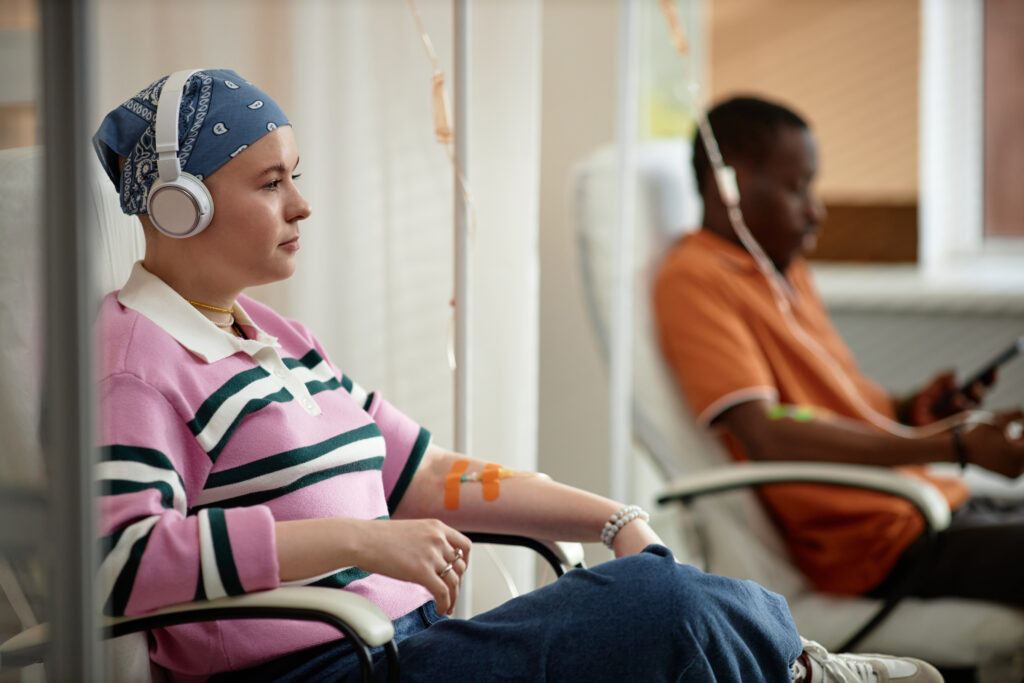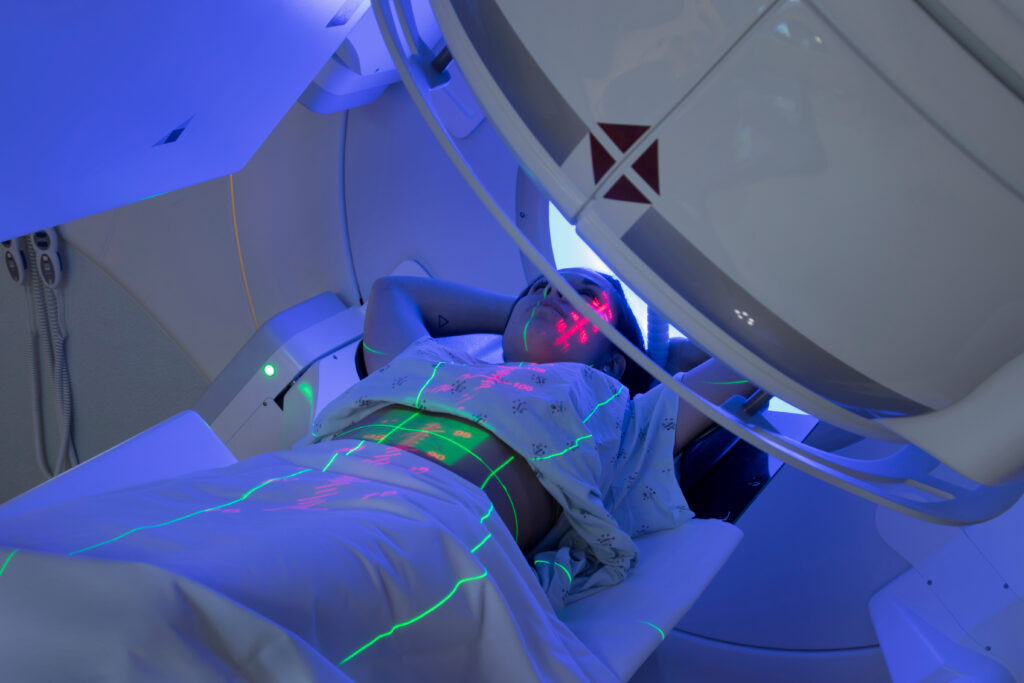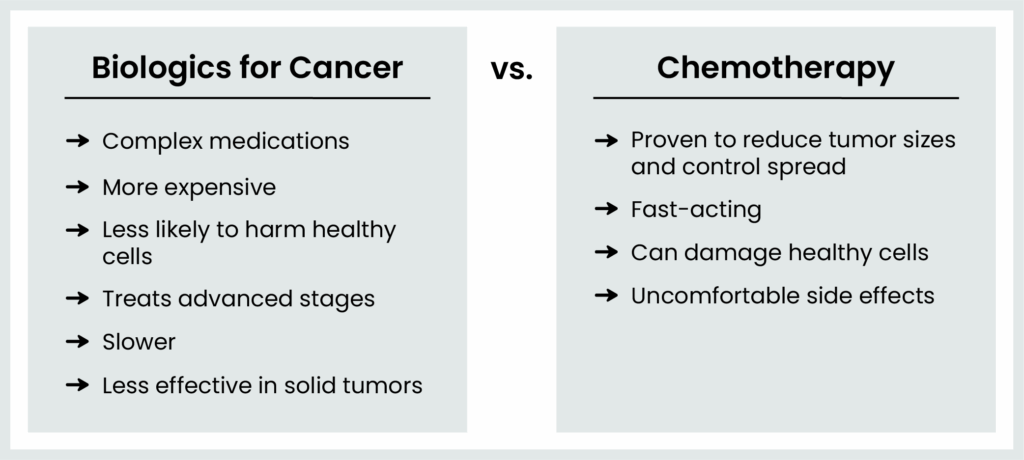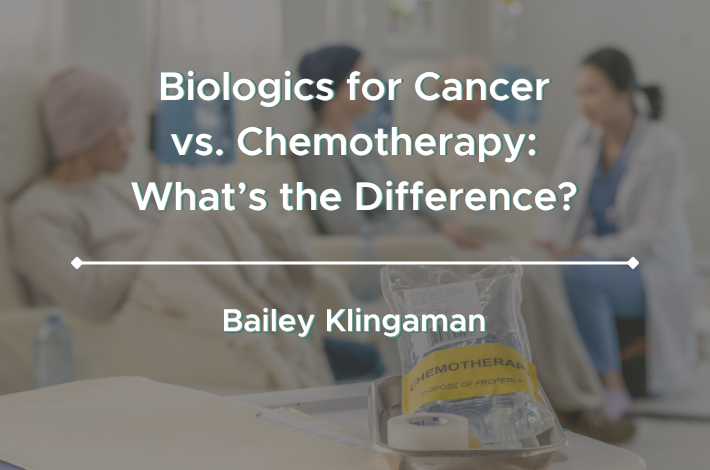Read about the differences between biologics for cancer and chemotherapy with Bailey Klingaman in this RxToolKit blog. When determining which is right for a patient, learn all about the different kinds of therapies, how they work, their effectiveness and their side effects.
Both biologics and chemotherapy are popular therapies used to treat and target cancer, but they each have their own applications. Before determining which therapy is the best approach for a patient, make sure you have the full picture of their differences, how they work, their effectiveness, and common side effects.
What is biologic therapy?
Biologics are medications made from organic life by removing or reproducing genetic materials from lifeforms. Biopharmaceuticals can be used to treat diseases that synthetic drugs cannot successfully treat; however, biologics are frequently more expensive and complicated medications.
Biologics include blood and blood products (i.e. plasma), vaccines, biosynthetic insulin, stem cell therapy, monoclonal antibodies, biologic disease-modifying antirheumatic drugs (DMARDs), immunotherapy treatments, and more.
Kinds of Biologic Therapy
There are many kinds of biologic therapy treatments, including adoptive T-cell therapy, cytokine therapy, targeted therapy, and more.
The most common kinds of biologic therapy use cytokines, proteins that regulate inflammatory and immune responses, to help boost the immune system and identify healthy and unhealthy cells. These therapies are interferons (IFN), interleukins (IL), colony-stimulating factors (CSF), and monoclonal antibodies (mAb).
Interferons are signaling proteins that “interfere” with viruses and harmful cells to prevent them from multiplying. They are naturally occurring or can be lab-made and help the immune system fight cancer cells. Interferons slow cell growth and encourage normal cell behavior, and they can treat some kinds of leukemia and Kaposi’s sarcoma.
Interleukins are a type of cytokine that’s primary function is to influence the growth, differentiation, and activation of immune cells. They also occur naturally in the body and can be lab-made. ILs encourage the growth of cancer-killing immune cells and are effective in treating melanoma and metastatic kidney cancer.
Colony-stimulating factors are glycoproteins that stimulate stem cells to create white blood cells that defend the body from bacteria and viruses. While CSFs do not directly affect cancer cells, they help make new blood cells which reduce infection risks and help patients recover from side effects of harsh chemotherapy and radiation treatments. They also increase the amount of stem cells in the body, which can prime someone for a stem cell transplant.
Monoclonal antibodies are lab-made proteins that stimulate the immune system. They are clones of the antibodies found in the immune system, and bind to one antigen only (depending on the antibody being cloned). Monoclonal antibodies are used to interrupt the growth of cancer cells, and locate and alert the immune system to destroy the cells. They can be used to treat different kinds of cancer, including lymphoma, tumors, melanoma, and leukemia.
What is immunotherapy?
Historically, the most common treatment options for cancer have included surgery, chemotherapy, radiation, and targeted therapy, but immunotherapy is a kind of biologic therapy that has recently shown a lot of promise. Immunotherapy doesn’t directly target cancer cells, but uses drugs that target the body’s immune system to recognize and attack the cells more effectively.
The different forms of immunotherapy include immunomodulators, cancer vaccines, adoptive cell transfers, and more. Immunotherapy has been effective in treating advanced cases of cancers like melanoma, kidney cancer, lung cancer, and others.
How do biologics treat cancer?
As mentioned, biologic therapy uses living organisms, substances derived from organisms, and lab-made reproductions of those substances to fight cancer. Depending on the kind of biologic therapy, biologics can attack cancer cells directly or stimulate the body to target them indirectly.
In targeted biologic therapy, biologic drugs interfere with the growth and/or survival of cancer. It can work by blocking cancer cell signals to stop growth, cut off the blood supply to tumors, and deliver toxins to the cancer cells.
In immunotherapy, treatment can encourage immune responses to attack cancer cells in the body, can involve training immune cells to attack cancer cells and then inject those into the body, and can make cancer cells easier to locate by the immune system.
What is chemotherapy?

Chemotherapy is a treatment involving drugs that are toxic to cells, especially those that rapidly divide like cancer cells. Formerly known as cytotoxic agents, chemotherapy drugs harm cancer cells directly by damaging and interfering with their DNA or metabolic processes and causing them to trigger apoptosis.
Kinds of Chemotherapy
Different kinds of chemotherapy drugs and treatments can be grouped based on their chemical structure, their interactions with other kinds of chemotherapy, and how they work. The types of chemotherapy include alkylating agents and nitrosoureas, antimetabolites, anti-tumor antibiotics, topoisomerase inhibitors, and mitotic inhibitors.
Alkylating agents prevent cancer cells from reproducing by damaging the DNA. They are used to treat many different types of cancer, including leukemia, lymphoma, Hodgkin disease, sarcoma, lung cancer, breast cancer, and more. Nitrosoureas are a kind of alkylating agent that specifically travel into the brain and kill cancer cells.
While platinum drugs are not technically alkylating agents due to different methods of damaging DNA, they are often grouped with alkylating agents because they both disrupt DNA synthesis and can affect cells in different phases of the cell cycle.
Antimetabolites prevent cancer cells from creating the genetic materials needed to make new cells. By interfering with the DNA and RNA of the cancer cells, the cell cannot replicate itself. Antimetabolites are commonly used to treat breast cancer, ovarian cancer, leukemia, and more.
Anti-tumor antibiotics change the DNA in the cancer cells to prevent them from growing and reproducing. Anthracyclines are a specific kind of anti-tumor antibiotic that bind with the cancer cell DNA so it cannot reproduce and are used for a wide variety of cancers.
Topoisomerase inhibitors prevent the enzyme topoisomerase from allowing the DNA to replicate itself, stopping cell reproduction and potentially damaging the DNA. They are used to treat leukemia, and lung, ovarian, gastrointestinal, colorectal, and pancreatic cancers.
Mitotic inhibitors interfere with the cell’s ability to complete mitosis (divide and make new cells). They can damage cells in all cell phases by restricting enzymes from producing proteins needed for cell reproduction. Mitotic inhibitors can treat breast cancer, lung cancer, myeloma, lymphoma, and leukemia.
Corticosteroids are not typically considered chemotherapy treatments, but they are often used alongside chemotherapy. While some corticosteroids can aid in the killing of cancer cells and prevent them from dividing, they are primarily used during chemotherapy to manage side effects like inflammation, pain, and nausea.
There are other kinds of chemotherapy that do not fall into these categories because of their behavior. These include all-trans-retinoic acid, arsenic trioxide, asparaginase, eribulin, hydroxyurea, ixabepilone, mitotane, omacetaxine, pegaspargase, procarbazine, romidepsin, and vorinostat.
How does chemotherapy treat cancer?
The objective of chemotherapy is to keep cancer cells from growing and multiplying. Depending on the specific treatment plan, chemotherapy can be given before surgery to shrink a tumor, after surgery to eliminate all remaining cancer cells, or both. It can also be given in combination with other cancer treatment options, such as radiation, immunotherapy, or targeted therapies.

While the goal of chemo is to stop the cancer from progressing, more specific goals depend on the individual treatment and circumstances. Reduction of cancer cells and tumors, control over cancer growth or the spread to other areas of the body, relief from symptoms when the cancer cannot be eradicated, and keeping the cancer in remission are all possible with chemotherapy.
What are the side effects of biologics for cancer vs. chemotherapy?
In rare cases, biologics can cause the immune system to attack healthy cells, which can lead to swelling and irritation. Biologic therapy can have a wide array of side effects, varying in type and intensity and dependent on the kind of biologic therapy. Pain, soreness, redness, itchiness, and rash at the site of injection or infusion are common.
Many chemotherapy drugs can damage healthy cells in addition to cancer cells, and can have side effects like nausea, fatigue, and hair loss. It is the damage to healthy cells that causes the majority of side effects of treatment.
Which therapy is most effective?
Effectiveness of treatment depends on many factors, including stage of cancer, kinds of cancer, symptoms, and more.
Biologic immunotherapy can be used at various stages of cancer development, but is especially effective in later stages or when other treatment options have not had much success. Recently, it has been used more as a first-line treatment option for cancers like melanoma and lung cancer.
Immunotherapy can specifically target cancer cells over healthy cells, but can be slower and vary in efficacy. The effectiveness of immunotherapy in solid tumors is limited and can largely depend on specific markers in the tumor and tumor-targeting immune cells.
Chemotherapy can be used at all stages of cancer and is often used as a first-line treatment option. It has effectively reduced tumor sizes and controlled the spread of cancer, and can help relieve symptoms for more advanced stages.
Which therapy is better, biologics or chemotherapy?
Both kinds of cancer treatment have their own benefits and downsides.
- Biologics tend to be more complex and expensive, but are less likely to harm healthy cells. While immunotherapy in particular has been effective in treating cancer in advanced stages or cases where chemo has not worked, it can be slower and has not been found to be as effective in solid tumors.
- Chemotherapy is often an option for treatment and has demonstrated an ability to reduce tumor sizes and control the spread of cancer. It can be more fast-acting than some biologic options, but can also damage healthy cells and include uncomfortable side effects.

Research has also shown that a combination of biologic therapy and chemotherapy may be more effective than either option alone by enhancing the immune system’s ability to fight cancer and modulating the tumor’s microenvironment to be more receptive to immune attacks.
Studies are still being conducted on biologic therapies for cancer treatment and there are constantly new findings about cancer and its treatment options. Both biologics and chemotherapy are appropriate treatment plans for cancer, and each have their own methods, symptoms, and applications.
When determining which treatment is best, be sure to approach the situation holistically and consider the patient, kind of cancer, and all of the options available.






